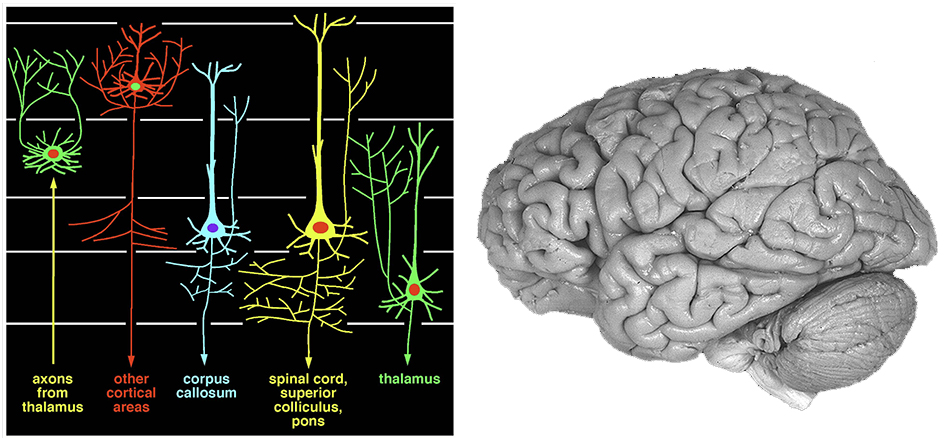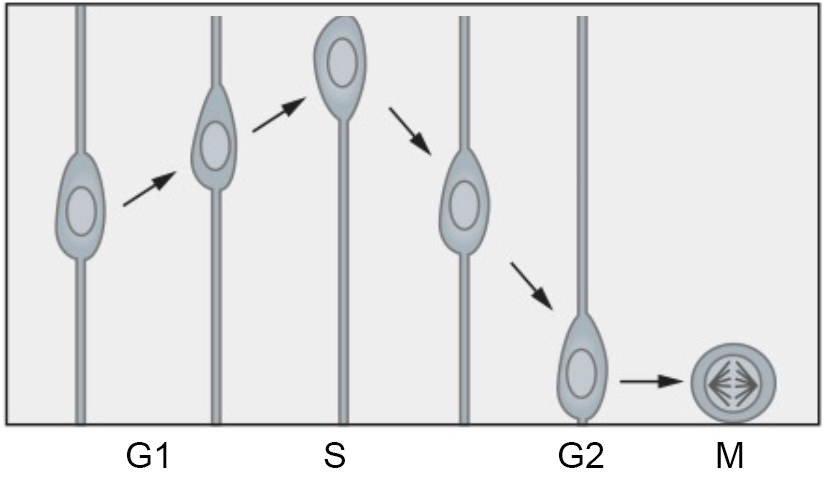Summary
The development of the central nervous system encompasses a series of critical processes, including the production of neurons from progenitor cells, the determination of discrete neuronal phenotypes, the migration of young neurons into appropriate positions within the brain, and the formation of specific synaptic contacts. These processes ultimately generate the formation of precisely wired neuronal circuits that underlie complex behaviors. The goal of our work is to understand how neurons in the developing cerebral cortex are produced, assigned specific phenotypes, and wired together into functional circuits.
Background
Sitting at the apex of neural processing in the mammalian brain is the cerebral cortex, the convoluted sheet of neurons covering the two cerebral hemispheres. Neurons within the neocortex underlie our most sophisticated cognitive and perceptual abilities and are thus highly specialized for the analysis of sensory inputs or the generation of motor outputs. The position, connectivity, and morphology of each neuron reflects its particular function. Although neurons in the adult brain are organized in highly ordered and differentiated arrays, these cells arise from dividing progenitor cells of a simple neuroepithelium in which cells appear morphologically indistinguishable. Our lab is interested in how diverse neuronal phenotypes are generated from apparently homogeneous progenitors in appropriate numbers, times, and positions during the development of the cerebral cortex. Our studies focus on key steps in neurogenesis including the molecular control of cell number, the decision to generate a neuron, and cell type specification.

The neurons of the neocortex are organized in two dimensions relative to the cortical surface. Tangential to this surface, different areas subserve a variety of functional modalities. Each area is characterized by a set of distinctive architectural features, and most importantly by the pattern of both incoming and outgoing axonal connections. These connections underlie the functional specificity of neurons in each area: for example, auditory cortex receives information that originates from neural structures in the ear, whereas visual information is delivered from the retina to neurons of the visual cortex. In the perpendicular dimension, the cortex is comprised of six sheets or layers, each of which is defined by the density and morphology of its constituent neurons. Thus, along a radial line through the cortex, one encounters a variety of neurons with differing physiological properties and axonal connections, each typical of that layer. A general rule of thumb for projection neurons in sensory areas of cortex is that neurons in the upper layers 2 and 3 send long-distance axons to other cortical areas, whereas neurons in the deep layers 5 and 6 extend axons to subcortical targets. This radial stack of neurons forms the cortical column, a minimal unit of neurons and connections required to analyze a small portion of the sensory world.

Neurons of the neocortex are generated from proliferating cells of the telencephalic ventricular zone. During the cell cycle, the nuclei of cortical progenitor cells undergo a series of "elevator movements" that correlate with their progression through the cycle. During DNA synthesis, or the S-phase of the cell cycle, nuclei occupy the outer half or third of the ventricular zone. In G2, nuclei descend rapidly toward the ventricular surface, where cells then complete mitosis. Entry into the G1 phase of the cell cycle is accompanied by an outward movement of the nucleus, as each daughter cell prepares either to reenter the cell cycle or exit the ventricular zone and differentiate. During neurogenesis, the latter choice is accompanied by the migration of the young neuron along radial glial fibers through the cell-sparse intermediate zone (future white matter) and into the cortical plate, which will later form the layered adult cerebral cortex. Neurons are generated in an orderly progression, with cells of the deepest cortical layers born first, followed by cells of the middle and finally the upper layers. This inside-out pattern of neurogenesis produces neurons within a given layer that share similar birthdays as well as common functional properties and connectivity. Over the years, our lab has explored the cellular and molecular mechanisms that enable young cortical neurons to acquire a distinct fate during development.



